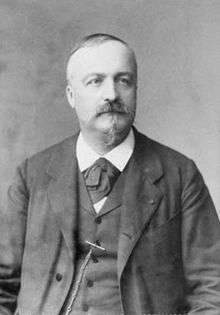Marie Alfred Cornu
Marie Alfred Cornu (French: [kɔʁny]; March 6, 1841 – April 12, 1902) was a French physicist. The French generally refer to him as Alfred Cornu.
Marie Alfred Cornu | |
|---|---|
 | |
| Born | March 6, 1841 |
| Died | April 12, 1902 (aged 61) |
| Awards | Rumford Medal (1878) |
| Scientific career | |
| Notable students | Albert A. Michelson[1] |
Life
Cornu was born at Orléans to François Cornu and Sophie Poinsellier.[2] He was educated at the École polytechnique and the École des mines. Upon the death of Émile Verdet in 1866, Cornu became, in 1867, Verdet's successor as professor of experimental physics at the École polytechnique, where he remained throughout his life. Although he made various excursions into other branches of physical science, undertaking, for example, with Jean-Baptistin Baille about 1870 a repetition of Cavendish's experiment for determining the gravitational constant G, his original work was mainly concerned with optics and spectroscopy. In particular he carried out a classical redetermination of the speed of light by A. H. L. Fizeau's method (see Fizeau-Foucault Apparatus), introducing various improvements in the apparatus, which added greatly to the accuracy of the results. This achievement won for him, in 1878, the prix Lacaze and membership of the French Academy of Sciences (l'Académie des sciences), and the Rumford Medal of the Royal Society in England. In 1892, he was elected a member of the Royal Swedish Academy of Sciences. In 1896, he became president of the French Academy of Sciences. Cornu was the President of the Société Astronomique de France (SAF), the French astronomical society, from 1897-1899.[3] In 1899, at the jubilee commemoration of Sir George Stokes, he was Rede lecturer at Cambridge, his subject being the wave theory of light and its influence on modern physics; and on that occasion the honorary degree of D.Sc. was conferred on him by the university. He died at Romorantin on April 12, 1902.[4]
The Cornu spiral, a graphical device for the computation of light intensities in Fresnel's model of near-field diffraction, is named after him. The spiral (or clothoid) is also used in geometric design of roads. The Cornu depolarizer is also named after him.
References
- Loyd S. Swenson, Jr., The Ethereal Aether, University of Texas Press, 2013.
- Hockey, Thomas (2009). The Biographical Encyclopedia of Astronomers. Springer Publishing. ISBN 978-0-387-31022-0. Retrieved August 22, 2012.
- Bulletin de la Société astronomique de France, 1911, vol. 25, pp. 581-586
- Chisholm 1911.
- Attribution
- Chisholm, Hugh, ed. (1911). . Encyclopædia Britannica. 7 (11th ed.). Cambridge University Press.